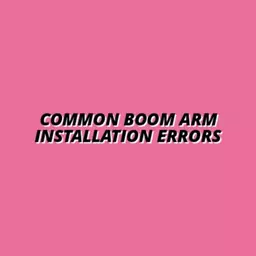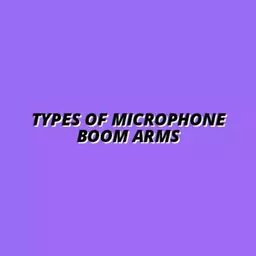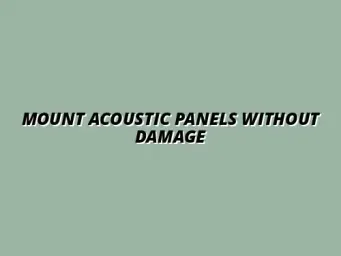Effective audio performance hinges not only on quality gear but also on how well that gear is organized. What if a few simple changes to your workspace could enhance your creativity and save you valuable time? Dive into the world of audio organization to unlock your potential!
Key Takeaways
- Effective organization boosts accessibility, allowing you to focus on creativity instead of searching for equipment.
- Regular maintenance becomes easier in an organized space, helping you identify wear and tear quickly.
- A tidy workspace protects your investment by reducing the risk of accidents and environmental damage to your gear.
- Implement tailored storage solutions and cable management techniques to optimize your audio setup.
- Establish a gear check-out/check-in policy to track usage and maintain accountability.
Key Strategies for Effective Audio Equipment Organization
Organizing your audio gear can significantly improve your workflow and protect your investment. Below are the key strategies to implement in your workspace.
Organized Storage Solutions
Implement tailored storage solutions for different types of audio equipment, ensuring easy access and efficient use of space.
Cable Management Techniques
Utilize labeling and color-coding strategies to prevent confusion and ensure cables are tidy and easily identifiable.
Regular Maintenance
Engage in regular checks for wear and tear, which is simplified when equipment is well-organized.
Environmental Considerations
Consider humidity and temperature when storing equipment to prevent damage and ensure longevity.
Understanding the Importance of Organizing Audio Gear for Optimal Performance
When it comes to achieving the best audio quality, organization plays a crucial role. Disorganized gear can lead to unnecessary stress and lost time, which can affect your overall performance. At Tidy Audio Desk, we understand how essential it is to maintain an efficient audio workspace, especially for creators and professionals who rely on their setups for streaming, podcasting, or recording.
Have you ever struggled to find a specific mic or tangled cables right before a session? Effective organization can save you from these frustrating moments! By prioritizing organization, not only can you enhance accessibility, but you can also maintain your gear better, ensuring that everything runs smoothly when you need it most.
Why Effective Audio Equipment Organization Matters
Effective organization of audio equipment isn’t just about aesthetics; it’s about functionality too. A well-organized space promotes easier access to your gear, making your workflow more efficient. This means you can focus more on your creativity and less on hunting down equipment!
When everything has its place, you’ll find that maintenance becomes a breeze. Regularly checking your gear for wear and tear is essential, and having an organized setup makes it easier to spot issues that need attention. Plus, it shows that you value your investment in quality audio equipment, which can ultimately save you money in the long run. For those working with boom arms, consider how cleaning your boom arm can contribute to the longevity and performance of your audio setup.
💡 Planning an echo-free audio desk? Start with desk setup inspiration and acoustic routing. 👉 Explore the Setup Ideas Guide
Enhancing Accessibility and Maintenance
Accessibility is key in any audio workspace. Think about it: if you can grab your microphone or cables quickly, you can stay in the creative flow without interruptions. An organized setup allows you to have everything you need at your fingertips, enhancing your overall experience.
Regular maintenance is also simpler when your equipment is organized. Instead of rummaging through piles of gear, you'll have a clear view of what needs cleaning or repair. This proactive approach not only extends the life of your equipment but also ensures optimal performance during every session. What steps are you taking to ensure you have simple cable solutions for your desks?
Protecting Your Investment in Audio Gear
Your audio equipment is an investment, and protecting it should be a priority. Effective organization helps prevent accidents, like tripping over cables or knocking over microphones, which can lead to costly repairs. By creating a tidy workspace, you’re not just enhancing your productivity, but you’re also safeguarding your valuable gear.
Additionally, storing your equipment properly can protect it from environmental factors like dust or moisture. Consider using specialized storage solutions from Tidy Audio Desk to keep your gear safe and sound. With the right organization strategies in place, you can ensure that your investment continues to deliver quality sound for years to come! Considering neat desktop audio cable solutions can make a significant difference in protecting your gear and maintaining a professional workspace.
Strategic Approaches to Gear Storage Solutions
Now that we've established the importance of organization, let's dive into some strategic approaches for gear storage solutions. Keeping your workspace tidy is essential for maximizing performance and creativity. Here are some effective strategies tailored to different types of audio equipment.
Pro Tip
Did you know? Implementing a color-coded system for your cables not only helps in quick identification but also adds a touch of personalization to your workspace. Consider using colored electrical tape or cable sleeves to distinguish between different types of connections—this can save you precious minutes during setup and teardown!
Summary of Best Practices for Organizing Audio Gear
As we wrap up our discussion on organizing audio gear, it’s essential to keep some key takeaways in mind. Effective organization not only boosts your workflow but also ensures that your equipment remains in top shape for years to come. Here, I’ll share a concise list of best practices that I believe will help you establish a tidy audio environment.
- Implement organized storage solutions tailored to different types of gear.
- Adopt cable management techniques, such as labeling and color-coding, to prevent confusion.
- Consider environmental factors like humidity and temperature when storing equipment.
- Engage in regular maintenance to prolong the life of your audio gear.
By following these guidelines, you can create a more efficient and enjoyable workspace. Each practice contributes not just to the aesthetic appeal of your setup but also enhances the functionality of your audio equipment.
Key Takeaways for Effective Audio Equipment Organization
Reflecting on our earlier discussions, it’s clear that a well-organized audio workspace can significantly impact your creativity and productivity. I encourage you to review the storage solutions and systems we covered. For instance, using compartmentalized cabinets and innovative cable management tools is crucial for maintaining harmony in your audio environment.
Additionally, implementing a check-out/check-in system can bring structure to gear usage, allowing you to keep track of your equipment effectively. How often have you lost track of a cable or a mic? Building this accountability framework can save time and frustration!
- Review the types of storage solutions used: cabinets, racks, and containers.
- Establish a gear check-out/check-in policy.
- Incorporate maintenance routines for each piece of equipment.
Final thoughts: Regularly revisit these practices! Keeping your workspace organized can significantly enhance your audio experience. As the founder of Tidy Audio Desk, I can attest that investing time in organization pays off in performance and satisfaction.
Engaging with the Community: FAQs and User Experiences
Common Questions About Organizing Audio Gear
Many of you have questions about the best ways to organize your audio equipment. Let’s tackle some common queries that I often hear from fellow audio enthusiasts!
- How to choose the best storage products for audio equipment? Consider your specific needs, such as space constraints and the types of equipment you own.
- What are the most effective cable management solutions? Options include cable ties, sleeves, and color-coded labels for easy identification.
It’s important to remember that every setup is unique, so what works for one person might not work for another. By exploring different solutions, you can find what fits best in your workspace.
Sharing of Experiences and Tips on Gear Organization
I love hearing from the community about your experiences with organizing audio gear! Sharing insights and tips can lead to innovative solutions that benefit everyone. If you have tried a specific storage or management technique that worked wonders for you, please share!
- What toolkits or equipment have you found essential for your audio workspace?
- Do you have any DIY hacks for maximizing storage and organization?
Let’s create a space where we can all learn from each other! Your input can inspire others to optimize their setups, just as I aim to do through Tidy Audio Desk. Join the conversation and let’s enhance our audio environments together!
Recap of Key Points
Here is a quick recap of the important points discussed in the article:
- Prioritize Organization: A well-organized audio workspace enhances accessibility and efficiency, allowing you to focus on creativity.
- Implement Storage Solutions: Utilize tailored storage options like cabinets and racks to keep your gear in order.
- Cable Management: Adopt techniques such as labeling and color-coding to prevent confusion and tangling.
- Regular Maintenance: Conduct routine checks on your equipment to identify wear and tear, ensuring longevity and optimal performance.
- Protect Your Investment: Proper organization minimizes accidents and environmental damage, preserving the quality of your audio gear.
- Engage the Community: Share experiences and tips with fellow audio enthusiasts to learn innovative organization techniques.








